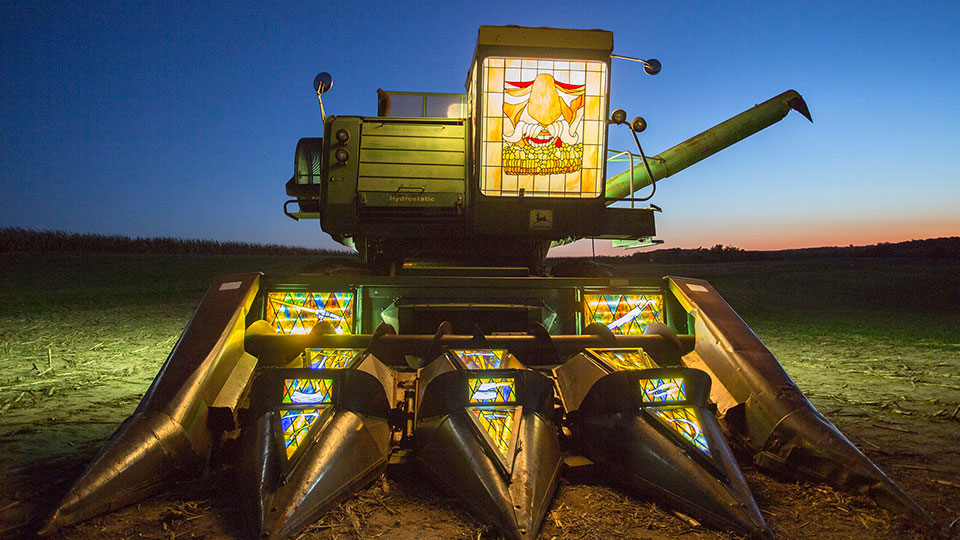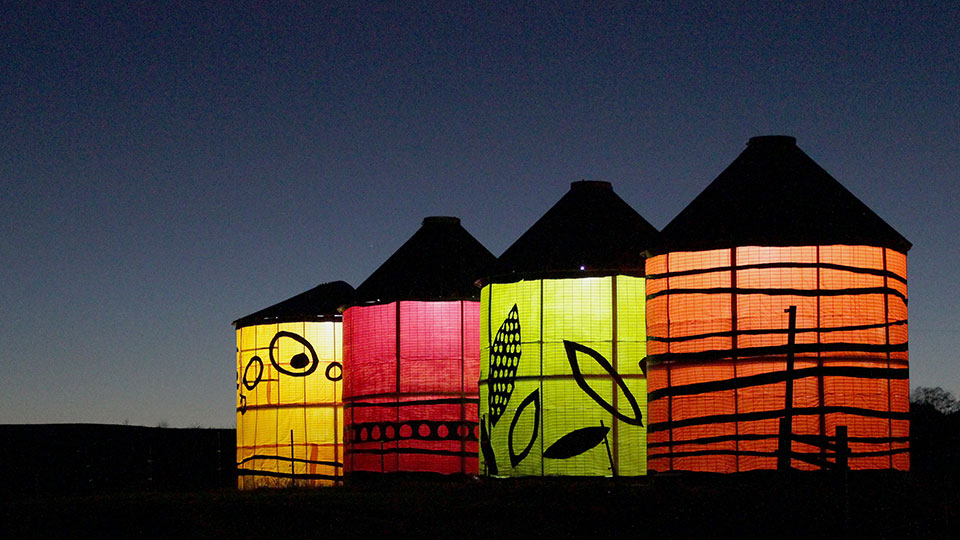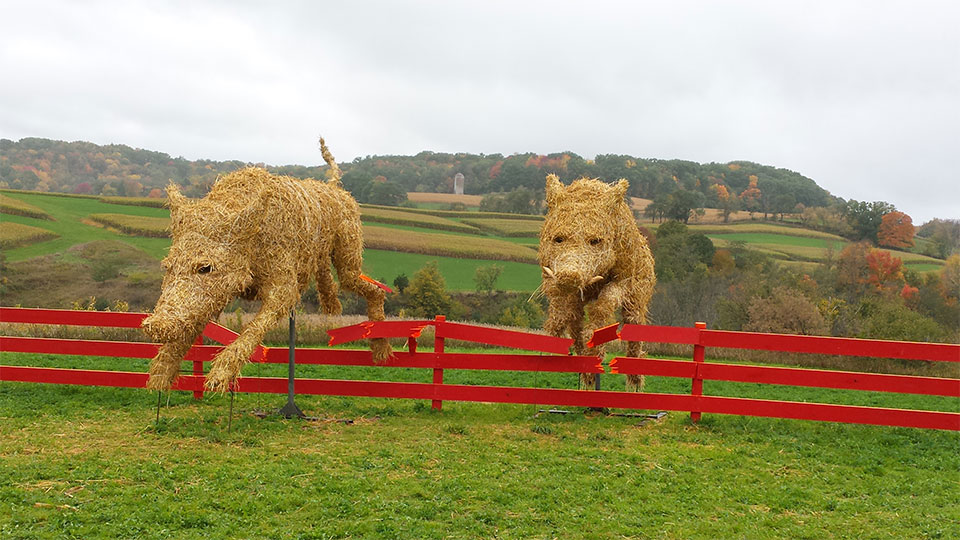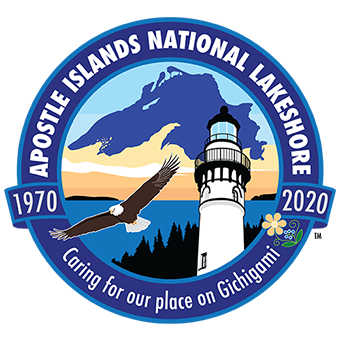By: Donna Neuwirth, Wormfarm Institute Executive Director and Co-founder
Fermentation Fest’s signature event The Farm/Art DTour Will Bring Together 20,000 Visitors From Urban and Rural Areas
During harvest season this fall, the Wormfarm Institute will collaborate with international artists and regional landowners to bring cultural events to the landscapes of Sauk County, Wis. The seventh iteration of the Farm/Art DTour duringFermentation Fest—A Live Culture Convergence will open October 6, 2018, through October 14. Fermentation Fest invites rural and urban visitors to explore their connections to the land and agriculture through lively, participatory programs, including fifty fermentation-focused classes ranging from bread to chocolate, kefir to beer; a keynote presentation by celebrated writer, agrarian activist, and ethnobotanist Gary Paul Nabhan; and the biennial Farm/Art DTour, a 50-mile circuit through Sauk County anchored by site-responsive artist installations on farmers’ land.
“In our present cultural moment, it’s essential that we renew and cultivate the connections that exist between rural and urban dwellers, said Donna Neuwirth, Wormfarm Institute Executive Director and Co-founder. “The Fest is only 55 miles northwest of Madison, and midway between Chicago and Minneapolis, perfectly situated to bring together our region’s most innovative chefs, scientists, artists, brewers, bakers, poets, and cheesemakers, each in their own way celebrating the asset-rich land we share.”
Beginning in Reedsburg, the Farm/Art DTour, the Fest’s signature event, leads visitors out and through the working landscapes and small towns of central Sauk County. Wormfarm Institute is preparing to welcome over 20,000 people from the upper Midwest and beyond to travel the 50-mile, self-guided route, punctuated by temporary art installations, pasture performances, educational Field Notes, food stands, and roadside poetry.
“The DTour is a multi-sensory, leisurely meander, but it’s also a site for experimentation and transformation,” Neuwirth said. “We want visitors to think deeply about their relationship to the land, and to each other.” This year, visitors can expect to encounter a true-to-scale, three-dimensional drawing of a farmhouse using aluminum tent poles; a large-scale kinetic artwork integrating the feathers of local birds; interactive stereo view installations of nineteenth and twentieth century Sauk County photographs; and other ambitious projects.
Neuwirth recommends that visitors begin at the Reedsburg Area Chamber of Commerce, which serves as the Fermentation Fest headquarters and resource center. The Chamber’s knowledgeable staff provide expert guidance to the Fest and the surrounding area. Visitors will want to pick up the free Event Guide, and buy the comprehensive 2018 DTour Map for $5, detailing artists and their installations as well other events and attractions along the route. The Guide and Map will be available at multiple sites starting in September.
Extensive details for advance planning can be found in mid-August at fermentationfest.com. Visitors are invited to participate on Instagram @fermentationfest and #fermfest.
Featured Artists
Originally from Madrid, Spain, David Sanchez Burr is a mixed-media artist residing in Lake Forest, Illinois. Burr creates site-specific pieces on social and environmental themes that encourage the audience to navigate, modify, and help author the experience of the work. He has exhibited and performed internationally, and is currently an Assistant Professor of Art at Lake Forest College.
Franck Feurté is a multi-media artist from Bordeaux, France. He has participated in festivals and exhibitions around the globe, creating kinetic artworks that render environmental forces visible and tangible. Fuerté’s site-specific work uses local materials to demonstrate the mutual relationships between people, birds, and their shared landscapes.
Sarah FitzSimons is a visual artist who builds permeable sculptures that interact with and derive meaning from their surroundings. FitzSimons has exhibited her work locally and internationally, including a solo exhibition at the Chicago Architecture Biennial. She is currently an Assistant Professor of Sculpture at the University of Wisconsin-Madison.
Returning artist and Sauk County resident Martha Glowacki is an established artist, curator, and exhibition designer. Her interactive sculptures are informed by histories of natural science and scientific illustration, often drawing from eighteenth and nineteenth century technology. She served fourteen years as the Director of the Wisconsin Academy’s James Watrous Gallery in Madison, Wisconsin.
Returning artist Peter Krsko has a background in Biophysics and Materials Science. He creates sculptural installations that mimic biological structures and invite the viewer to shape the work through participation. He has led science-based, interactive art events across the country, and has recently moved to Wisconsin from Washington, D.C.
Emerging artist Madeline Straka, of Milwaukee, Wisconsin, studied Industrial and Interior Architecture and Design at the Milwaukee Institute of Art and Design. Straka has received several awards for her design work. Her current practice employs animalistic forms inspired by folklore to explore mythologies of monsters and impossible beasts in contemporary contexts.
A jury of six arts professionals selected these artists through an open call that drew 60 proposals from eight countries.
Featured Presenters
Seed saver, agroecologist, and father of the local food movement, featured speaker Gary Paul Nabhan will share research from this book Food From The Radical Center: Healing Our Land and Communities ( Island Press, September 2018). Nabhan will also lead a workshop on five fermented beverages drunk in Pre-Columbian North America historically.
Presenter Lou Bank, of the group S.A.C.R.E.D. (Saving Agave for Culture, Recreation, Education, and Development), will lead multiple classes and events including a mezcal dinner, and tepache and vinegar workshop.
Author Misty Cook will lead a foraging trip focused on the Medicines of the Stockbridge-Munsee Band of Mohicans Tribe. Cook will draw from an eight-generation lineage to teach about the history, identification, and uses of these plants and trees.
Herbalist and forager Linda Conroy, of Moonwise Herbs, will prepare an adventurous “Wild Eats” dinner, including several courses of wild, local, whole, and fermented food, served family style. Each dish will contain a foraged food.
The Cheese Nun, a PBS documentary directed by Pat Thompson, will be screened. Sister Noella Marcellino, “The Cheese Nun,” takes viewers on a fascinating and delightful personal journey as she becomes a champion for artisanal cheese-makers on both sides of the Atlantic.
Special guest Tara Whitsitt—dubbed by The New York Times as ‘the Johnny Appleseed of Pickling’—will lead pop-up classes and events in her fermentation school bus.
About Wormfarm Institute
The Wormfarm Institute is a nonprofit organization in Reedsburg, Wis., working to build a sustainable future for agriculture and the arts by fostering links between people and the land. An evolving laboratory of the arts and ecology and fertile ground for creative work, the Wormfarm explores the links between rural and urban communities within and beyond the food chain, creating opportunities for cross-sector collaboration. Learn more at wormfarminstitute.org.
________________________
CALENDAR LISTING
Fermentation Fest—A Live Culture Convergence, Oct. 5–14, 2018, Reedsburg, Wis. A multifaceted food and farming festival celebrating live culture in all its forms—sculpture to yogurt, poetry to mezcal. Featuring the 50-mile Farm/Art DTour, scenic farmland punctuated with temporary art installations, pasture performances, and more. Classes and tastings about fermented food and drink, farming, and rural-urban connections. Explore, learn, taste, and enjoy live culture. Learn more at fermentationfest.com
Community Revitalization Through Creative Placemaking
The Wormfarm Institute’s work occurs across sectors, connecting urban and rural, people and land, culture and agriculture. It serves as a national model for rural creative placemaking, defined as asset-based community economic development with arts at its core. The U.S. Department of Agriculture (USDA) describes the Institute’s award-winning work as an innovative rural-development strategy.




